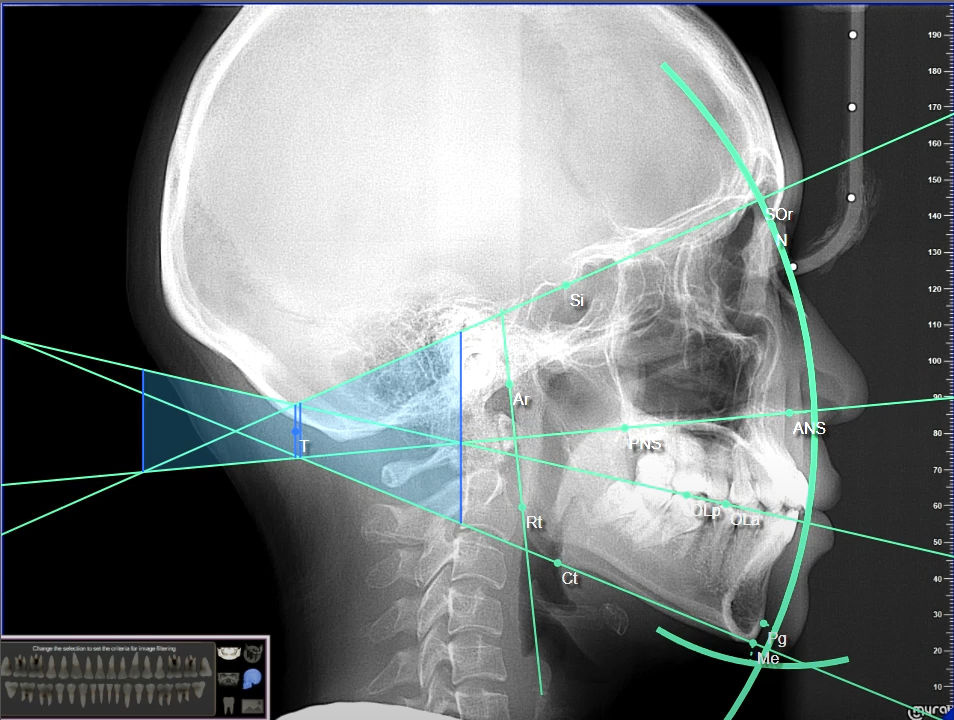
The 2010 Jefferson Cephalometric Analysis evolved from the Sassouni Archial Analysis by Dr. Vikan Sassouni, Sassouni Plus and Simplified Sassouni Plus Analysis by Dr. Richard Beistle and the Koski Circle Analysis. However, it distinctly used the Cranial plane and Center “T” to replace the Parallel plane and the Point O of the mentioned analyses. It provides an ideal antero-posterior position of the maxilla and mandible and the vertical position of the mandible. It also helps predict the postoperative maxillomandibular position after the functional appliance therapy. It claims to be the simplest, fastest and one of the most accurate cephalometric analyses of this time. The landmarks used in the analysis are supraorbitale, the more stable and accurate anatomic porion, sella inferior, anterior nasal spine, posterior nasal spine, constructed gonion, occlusal points on the molars and bicuspids, nasion, pogonion and menton. The additional landmarks, however, are the clivus, roof of orbit, basisphenoid, greater wing of sphenoid, ethmoid cribriform plate and lateral wall of orbit. The cranial plane replaces Sassouni’s parallel plane since it is easier to locate and trace. The four major planes derived from the points are the cranial plane, palatal plane, functional occlusal plane and the mandibular plane. These planes converge then diverge as they extend posteriorly. Perpendicular lines are drawn on the points of the convergence. The midpoint of the shortest perpendicular line drawn is the Center “T”. The anterior arc is formed from the Center T to nasion going inferiorly through a compass. This arc helps in evaluating the esthetic and physiologic position of the upper and lower jaws. The Age 4 vertical arc is drawn from a radius measured by the supraorbitale and the ANS sliding down the menton area. Add 10mm more to the previous radius to draw the Age 18 vertical arc below and parallel to Age 4 vertical arc. The anteroposterior position of the jaws should be within 2mm of the anterior arc regardless of the age, sex or race except for the lower facial height which varies as the patient grows.
Jefferson Analysis is rather visual and does not require comparison with values according to normal angular and linear standards. The analysis aims “to treat a beautiful face and smile.” Dr. Yosh Jefferson explained the philosophy of facial beauty in six points. First, a face and body, which are divinely proportioned, are beautiful and healthy. Second, there exists a universal norm for a beautiful face. Third, the divine proportion, being equal to beautiful, is the basis for the universally accepted norm of facial beauty. Fourth, all living beings are genetically inclined to grow and develop towards the divine proportion. Fifth, more than genetics, environmental factors predominantly cause facial and body disproportion or abnormalities. Lastly, the biologic equation applicable to all humans is Divine proportion=facial beauty=TMJ health=physiologic harmony=fertility=Total Health and Wellness=Quality of Life.
Dr. Jefferson used the terms prognathic and retrognathic to describe the anteroposterior position of the skeletal structure, while retrusive and protrusive are applied to the position of the dentition. He came up with his own Jefferson Skeletal Classification of Malposition consisting of Skeletal I (normal both jaws), IIA (prognathic maxilla), IIB (retrognathic mandible), IIC (prognathic maxilla, retrognathic mandible), IIIA (retrognathic maxilla), IIIB (prognathic mandible), IIIC (retrognathic maxilla, prognathic mandible), BR (Bi-skeletal retrognathic) and BP (Bi-skeletal prognathic). The lower facial height is assessed as short, normal or long. The analysis may also be used to assess and treat temporomandibular and airway obstruction through repositioning the mandible anteroinferiorly to the neuromuscular position to reduce the pharyngeal compression. While palatal expansion can help reduce nasal compression due to narrow palatal arch. The analysis is another very useful tool for the overall assessment and treatment planning by the orthodontist.
Source: Jefferson Cephalometric Analysis, Tracing and Interpretation Manual, Yosh Jefferson DMD, 2009